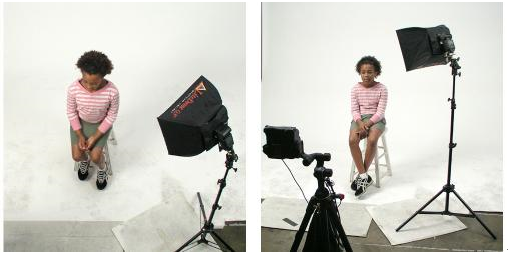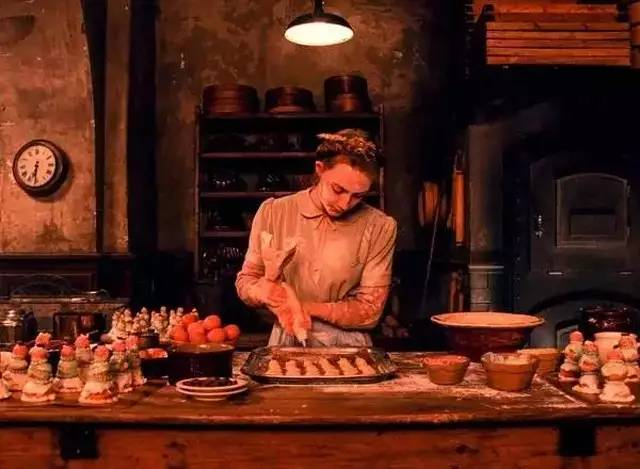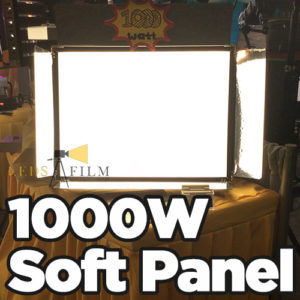Table of Contents
Portrait Photography Skills
- Shape shaping
(1) Lighting method
In photography, lighting is a creative work, it not only reflects the photographer’s personality and style, but also related to the success or failure of a work.
The basic method of using lighting to decorate and shape the image of a person is: use purposeful to highlight the shape and characteristics of the subject, while using shadows to cover certain defects of the face.
For example, when shooting with front metering, a shadow will be formed on the backlight side of the subject’s face. At this time, by adjusting the illumination angle of the light source, the shadow part is moved to the bright part, so that the area of the shadow is increased, and the light is bright. Department shrinks. Once the shadow area is larger than the bright part, the subject will look thinner.
And conversely, let the bright part move to the shadow part, when the area of the bright part is larger than the area of the dark part, it will make the subject feel fatter.
The lighting method is not only used to cover up defects, but also often used as decoration. For example, after the light of the subject has been determined, a backlight or side backlight is appropriately added to brighten the outline of the subject, or it can be used directly to enhance the texture of the hair, which can also achieve further beautification of the subject Effect.
①Light characteristics
In photography, the study of light characteristics generally starts from six aspects: luminosity, light quality, light position, light type, light ratio and light color.
- Luminosity
Luminosity is the most basic factor of light. It is the general term for the luminous intensity of the light source and the brightness of the light on the surface of the object. Luminosity is directly related to exposure. Large luminosity requires a small amount of exposure; low luminosity requires a large amount of exposure.
In addition, the size of the luminosity also indirectly affects the size of the depth of field and the clarity or blur of moving objects. Large luminosity is easy to produce the effect of large depth of field and clear image, while small luminosity is easy to produce the effect of small depth of field and blurry moving image.
- Light position
The light level refers to the direction of the light source and the position of the light source relative to the subject. In photography, the light position determines the location of the subject’s brightness and darkness, but also affects the texture and form of the subject. The light level can be ever-changing, but when the position of the subject and the camera is relatively fixed, the light level can be divided into six types: forward light, side light, back light, top light, foot light and scattered light.
- Light quality
Light quality refers to the hard and soft characteristics of light. The so-called hard refers to the clear and dense shadows produced by light, with sharp contours and high contrast. The so-called soft means that the shadows produced by the light are soft and unclear, with gradual contours and low contrast.
Hard light has obvious directionality, it can make the subject have a sharp contrast between light and dark, which is helpful for the performance of texture. Hard light often gives people a sense of fortitude and life. Soft light has no obvious directionality. It is suitable for reflecting the shape and color of objects, but it is not good at expressing the texture of objects. Soft light tends to give people a soft and delicate feeling.
- Light type
As far as the subject is concerned, there is often more than one type of illuminating light, and various types of light have different functions and effects. Light type refers to the effect of various light on the subject during shooting. Light types are usually divided into five types: main light, auxiliary light, contour light, decorative light and background light.
Main light
The main light is the main illuminating light of the subject, and it plays a leading role in the expression of the shape, contour and texture of the object. When shooting, once the main light is determined, the basic lighting and tone of the picture can be determined.
It should be noted that for a subject, there can only be one main light. If several light sources are used as the main light at the same time, the subject will either receive the light equally, and the main light cannot be distinguished, and the picture will appear flat. Either several key lights simultaneously cast shadows on the subject, and the picture appears chaotic.
auxiliary light
The main function of the auxiliary light is to increase the brightness of the shadow parts produced by the main light, so that the dark parts also show a certain texture and level, and at the same time reduce the image contrast. In the use of auxiliary light, it should be clear that the intensity of the auxiliary light should be less than the intensity of the main light. Otherwise, it will cause an overwhelming effect, and it is easy to have obvious auxiliary light projection on the subject, that is, the phenomenon of “light clamping”.
Contour light
Contour light is the light used to outline the contour of the subject. Contour light gives the subject a sense of three-dimensionality and space. Backlight and side backlight are often used as contour light, and the intensity of contour light is often higher than that of the main light. A dark background helps to accentuate the contour light.
Decorative light
Decorative light is mainly used to decorate a part of the subject or display the level of details of the subject. The decorative light is mostly narrow light. The eye light and luminescence in portrait photography and the flares of jewelry in commodity photography are all typical decorative lights.
Background light
The background light is the light that illuminates the background, and its main function is to set off the subject and render the environment and atmosphere. Both natural light and artificial light can be used as background light. The background light is generally wide, soft, and uniform. In the use of background light, special care should be taken not to destroy the tone coordination and main shape of the entire picture.
- Light ratio
The light ratio refers to the difference between the light intensity of the bright part and the dark part of the subject. The light ratio is large, the contrast between the bright part and the dark part on the subject is large; on the contrary, the contrast between the bright part and the dark part is small.
Generally, the intensity of the main light and auxiliary light and the distance from the subject determine the light ratio. Therefore, there are two ways to adjust the light ratio when shooting:
①Adjust the intensity of the main light and auxiliary light. Increasing the intensity of the main light or reducing the intensity of the auxiliary light will make the light ratio larger, and vice versa, the light ratio becomes smaller.
②Adjust the distance from the main light and auxiliary light to the subject. Narrowing the distance between the main light and the subject or increasing the distance between the auxiliary light and the subject will make the light ratio larger, and vice versa, the light ratio becomes smaller.
- Light color
Light color refers to the “color” of light, and is also commonly referred to as color temperature. For black and white photography, light color is not very important. But in color photography, the color of light is very important. When shooting, you must choose a lighting source whose color temperature is consistent with the balanced color temperature of the film. Otherwise, the captured image will appear color cast.
②Commonly used studio lamps
The lighting method is more suitable for indoor portrait photography, you can freely increase or change the light position and effect of the light, and it can be said to be relatively simple in shaping the shape of the character.
Portrait photography has extremely strict requirements for the reproduction of images. Therefore, many subjects are placed in the studio for lighting and shooting. There are two kinds of light sources for studio lighting: tungsten lamp and electronic flash.
Because the electronic flash has the advantages of high luminous intensity, stable color temperature, low heat generation and low power consumption. Therefore, the current portrait photography studio lighting mostly uses electronic flash. Among them, umbrella lights, soft lights, fog lights, flood lights and spotlights are more commonly used.
- Umbrella lights
Reflective umbrellas of different textures and specifications are mounted on the floodlights to become umbrella lights. Umbrella lights are characterized by large light-emitting area, soft light, and weak contrast.
- Soft light
Adding a diffuser to the caps of various flash lights becomes a soft light. The light emitted by the soft light is formed by mixing the direct light from the flash lamp and the reflected light of the reflector, and then transmitting and diffusing through the soft light. The characteristic of soft light is that it can provide average and sufficient lighting, and the light emitted is soft, but the direction is generally stronger than that of umbrella lights. The contrast is clear, the projection is thicker than the umbrella lamp, and it has a good level of performance.
- Fog lights
Fog lamps are a special kind of lamps. The head of the fog lamp is made of a special flash head, and there is a reflective glass in front of the flash tube, and all the output light is the transmitted diffused light reflected by the reflector. Fog lights are particularly suitable for shooting commodities (especially objects with high finish). The feature of fog lamps is that they can provide very average and large-area lighting, with soft light, and excellent performance in detail levels and color saturation.
- Floodlight
Floodlights are the most commonly used lamps, which consist of an electronic flash with a reflector. The light emitted by the floodlight is direct hard light, with high brightness, strong directivity and high contrast, and the resulting projection is dense. In addition, the light value is high in the center of the optical domain, and the edge is significantly attenuated.
- Spotlight
Spotlights are usually equipped with a mirror spherical reflector behind the light source. The light projected by the light source is reflected by the reflector and focused by the front condenser to emit a parallel beam. Spotlights are characterized by emitting parallel or nearly parallel beams, with low light attenuation, high brightness, strong directivity, extremely hard light, and high contrast.
(To Be Continued)
